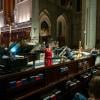
San Francisco Contemporary Music Players (SFCMP) will begin the new year with a program on Feb. 1 at the San Francisco Conservatory of Music.
The concert, called “Tracing Paths,” is set to feature music by Jonathan Bingham, Ian Kaneko, Olly Wilson, Zosha Di Castri, Manuel Calderón, and Thomas Adès.
According to SFCMP’s announcement:
“‘Tracing Paths’ is a special program, celebrating two people who have played important roles in the ensemble’s history: the late Olly Wilson, whose [piece] No More was premiered by SFCMP in 1985 and is being revived on the concert, and former Artistic Director Steven Schick, who will be returning as percussion soloist in the West Coast premiere of Zosha Di Castri’s Touch/Trace.”
Also on the program are two world premieres by graduate students in the conservatory’s Technology and Applied Composition department: Ian Kaneko’s Shaping Mist and Manuel Calderón’s Devastated.

Kaneko, who was born and raised in Seattle, says his output as a composer has “mostly involved writing for visual media such as video games or film, so I am very excited and honored to have the chance to work with an ensemble like SFCMP.
“Shaping Mist is my attempt to recreate a landscape of fog through music. As I wrote the piece, I was guided by the idea of formlessness. The performers who play the piece are not guided by standard musical structures of bars and beats. Instead, they can only find their place in the score relative to what they are hearing from each other.
“I decided to use electronic reverb effects to further blur the feeling of rhythm as well as suspend the music in the air like a mist. This reverb is then further manipulated to shape the sound in ways that complement the live performance.”
Calderón, who describes himself as a “composer and pianist of introspective, minimalistic, and instrumental music,” is originally from Colombia. He also says his career so far has focused on music for visual media.
About his piece for SFCMP, Calderón says, “Devastated opens with a sense of confusion and internal conflict, subtly alluding to the painful process of accepting a loved one’s death.
“The first section conveys the profound agony of coming to terms with their absence — it’s as fleeting and fragile as the sudden pop of a bubble, underscoring the harshness of life’s impermanence.
“As the piece progresses, the instrumentation grows denser, enriched by electronic elements that deepen the texture. This layered soundscape mirrors the emotional numbness that often accompanies grief, evoking that muted state where words and emotions seem unreachable.
“Anger and frustration become a means of seeking answers in the face of life’s cruel uncertainties. Devastated serves as a deeply personal journey through loss — a cathartic release of the darkness that can remain trapped within, a chance to confront the pain and ultimately begin the difficult process of healing.”

The concert also features voices familiar to Bay Area audiences: Bingham, on the conservatory’s faculty, pays homage to a trend among visual artists — from Pablo Picasso to Jean-Michel Basquiat — by presenting an untitled piece, leaving listeners to draw their own conclusions.
And then there’s Wilson, whose poignant No More draws together texts by three South African poets who fought against apartheid and for freedom and human dignity.
Wilson, a professor of music at UC Berkeley, where he taught from 1970 until his retirement in 2002, wrote a large body of works performed by orchestras all over the world, including the New York Philharmonic, the Royal Concertgebouw Orchestra, and the Moscow Philharmonic. He died in 2018.
Rounding out the program, conservatory musicians will join forces with SFCMP in a performance of Adès’s Chamber Symphony, Op. 2, which compresses the typical four-movement symphonic structure into a continuous 13 minutes, drawing on a broad range of references, including tango.




